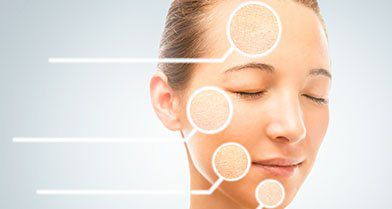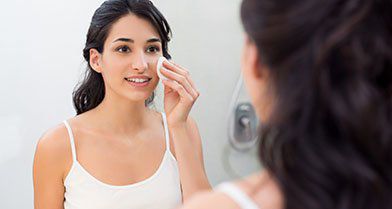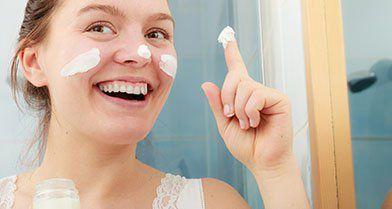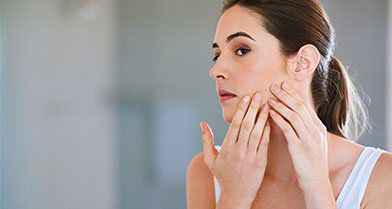What Are the Different Skin Types?
There are five basic skin types — normal, dry, oily, combination, and sensitive — and all of them can be linked to acne. This classification process is based on the way our skin keeps itself balanced, mainly by producing sebum (oil) and managing its hydration levels. Genetics and aging are also major factors in determining your skin type which can, as you age or make new lifestyle choices, evolve. Understanding the differences in skin types is an essential part of building any skincare routine because it helps you choose the right products to address your skin’s specific needs. Along with figuring out your skin type, understanding which type of breakouts you have (teenage acne, adult acne, or body acne) is also helpful for picking the right treatments. It’s easy to get confused about what your skin type or acne type is — here’s an overview so you can be confident in knowing what type of skin you’re in.
Dry Skin
If your skin generally feels itchy, tight, and rough (especially immediately after you’ve washed your face or showered), chances are you have dry skin. Redness and irritation can even pop up if something bothers your skin unexpectedly. Having dry skin is a result of less sebum (that’s the natural oil your skin produces), which means there aren’t enough hydrating and protective lipids to help your skin guard against external stressors like UV radiation, air pollution, extreme climate changes, etc. Lifestyle choices (think smoking, excessive alcohol, poor diet, increased sun exposure) can also lead to dry skin. Along with having to worry about more signs of aging (like pronounced fine lines and wrinkles), those with dry skin may also have to battle acne.
Oily Skin
Unlike dry skin, oily skin produces more sebum than usual. You’ll know if you have oily skin if a greasy shine appears by mid-day — often sooner, depending on how active your sebaceous glands are. Too much sebum can cause the dead skin cells your body is constantly shedding to stick together in that extra oil and become trapped inside your pores. Because of this, oily skin is often associated with enlarged pores and acne, including blackheads, whiteheads, and pimples.
For those with oily skin who like to wear cosmetics, keeping makeup on can be a challenge. While it may be tempting to wash or tone your face more frequently to keep that oiliness at bay, this is actually counterproductive and can make your skin more oily. That’s because your skin will actually produce more oil as a self-defense mechanism since it’s being stripped of all its natural oils. Instead, seek out products that help control your skin’s oil production and help maintain the right balance.
Combination Skin
As the name suggests, combination skin is both dry and oily. Like other skin types, genetics may be the root cause, though hormones may also be at play. Lifestyle choices (such as diet, smoking, or drinking) along with outside factors (like weather and pollution) can easily aggravate combination skin. This skin type can be frustrating to manage because your T-zone area (your forehead and nose) is oily, but your cheeks, chin, and neck can look and feel normal or even dry. Thankfully, with a little trial and error, those with combination skin can eventually adopt a skincare routine that effectively targets both skin types.
Teenage Acne
As if the awkward teen years aren’t hard enough to navigate, acne complicates things further. It’s no surprise that teenage acne pops up during this time because of the hormones responsible for puberty. In both girls and boys, this transitional phase for teens triggers the production of androgens (male hormones including testosterone and DHT). This group of hormones tells your glands to enlarge and produce more oil, one of the leading causes of acne. When that excess oil mixes with dead skin cells and bacteria, it can clog up your pores and lead to breakouts.
Adult Acne
Think you’re too old to have acne? Think again. Clinical studies suggest that approximately 40% to 55% of the adult population between the ages of 20 and 40 regularly battle acne. And it still plagues those in their 50s and 60s, too. Adult acne is linked to hormonal changes (think menstrual cycle, birth control pills, pregnancy, and menopause) and factors such as stress levels, genetics, diet, smoking, drinking, and a disproportionate amount of androgens. However, men don’t deal with the same hormonal issues as women, so their acne is more likely to be associated with shaving bumps, contact dermatitis and acne mechanica (caused by the friction caused from wearing a hat or sports equipment), stress, prescription drugs, hair products, and body-hugging workout gear or apparel.
Body Acne
Acne can appear anywhere on your body where you have pores or hair follicles… and that’s pretty much everywhere! Body acne comes in many forms — back acne (or "bacne") is most common, but breakouts can also appear on your neck, chest, shoulders, thighs, and butt. While the same factors that cause facial acne can also cause body acne (genetics, hormones, lifestyle habits, etc.), one of the primary triggers is sweaty athleticwear — particularly for those who work out regularly. Why? Because when that sweaty hat or sports bra stays on your skin, it traps dirt, oil, bacteria, and dead skin cells inside your pores, creating the perfect breeding ground for body acne. Other pore-blocking culprits include bras, tank top straps, scarves, backpacks and crossbody-bags, helmets, sweatbands, and any tight workout clothing, like leggings or workout tops.
If you struggle with body acne, you should also think about changing your linens more regularly. Sheets and towels — especially pillowcases — quickly accumulate dirt, bacteria, oils from your skin and hair, and dead skin cells, all of which can get back onto your skin and clog pores. Having separate towels for showering, washing your face, and washing your hands can also help.
What skin type and acne condition are you dealing with? Regardless of your age or skin type, proactiv has the right system for you. Each acne system in the proactiv family provides a skincare regimen to ensure you get the healthy, clear skin you’ve always wanted.










